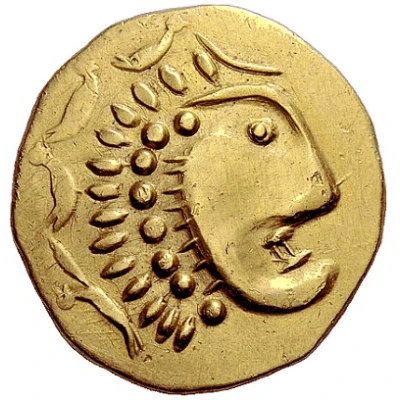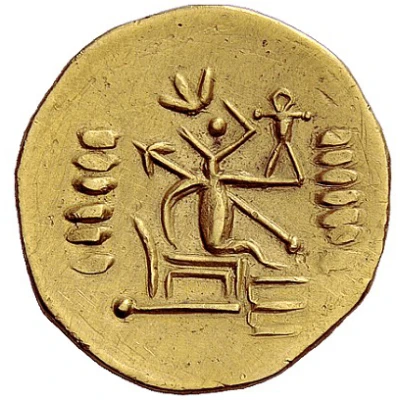


© Numismatica Ars Classica NAC AG
2 Stater - Lysimachos Kolchis imitation 100 BC - 100 AD
| Gold | 12.37 g | - |
| Issuer | Bastarnae Celto-Scythians (Central and Eastern Europe (ancient)) |
|---|---|
| Type | Standard circulation coin |
| Years | 100 BC - 100 AD |
| Value | 2 Stater = 40 Drachm |
| Currency | Stater |
| Composition | Gold |
| Weight | 12.37 g |
| Shape | Round (irregular) |
| Technique | Hammered |
| Demonetized | Yes |
| Updated | 2024-10-09 |
| Numista | N#200000 |
|---|---|
| Rarity index | 100% |
Reverse
Stylised Athena Nicephoros seated, facing right, holding spear on right shoulder and a small statue of Victory (Nike) in left hand. Trident pointing right below throne. Two columns of flattened pellets: seven in the left field and six in the right field, reminiscent of degraded legends from the original type.
Comment
The piece is possibly unique. Provenance:∙ Auctioned by Numismatica Ars Classica, Auction 74, 18 November 2013, Lot 322. Sold for 160,000 CHF.
∙ Auctioned by Auctiones AG 20, Zürich 1990, lot 29.
∙ Ex-"Un amateur érudit" collection.
Attribution:
The style, fabric, and design (specifically the ring of birds around the portrait) place this piece in the Kolchis group of barbarous imitations. All other known Kolchis specimens are staters (typically 5.0 – 6.0 g) or hemistaters (2.6 – 3.6 g); the latter may also be later staters struck at a significantly reduced standard. The coins were found in hoards from southern Caucasus to northern Italy, and from the Balkans to the Baltic, so they must have been used extensively, and exported far from their place of origin. Possible attributions include:
∙ Celto-Scythian Bastarnae tribes. The Bastarnae were close allies of the Pontic king Mithridates VI who minted staters with the portrait of king Lysimachus. After Mithridates was defeated by Rome in 66 BC, he fled to Colchis, where the imitation staters were likely first minted [3].
∙ Celto-Dacian tribes from Transylvania [4].
∙ Tribes in Kolchis, in the southern Caucasus, on the southwestern shore of the Black Sea, in modern-day Georgia [5].
∙ Tribes in Abkhazia, the northwestern part of ancient Colchis, modern-day Georgia, based on the concentrated hoards found in Abkhazia, western Georgia, and Adjaria [6].
∙ Balkan Celtic tribes (Derek Allen).
Design:
∙ The obverse of this type may be derived from the head of Heracles on the or the deified head of Alexander III on the .
∙ The reverse is taken from that were based on the royal coinage of Lysimachus.
∙ Arslan divides the series into three groups with distinct style and metrology [4]. This distater most closely resembles the staters of Group III, but it lacks a diagnostic monogram beneath the chin.
Dating:
∙ The trident first appeared on Byzantium staters and tetradrachms in the late 3rd Century B.C., and became popular in the 2nd and early 1st Centuries B.C., so the first gold imitations must have been minted around this date.
∙ A unique stater in Arslan's group III has on its reverse "IB" in the left field and "ETOYC" beneath the trident. ETOYC (meaning year) was used on Roman provincial coins to indicate dates. "IB" would stand for the 12th regnal year of an unidentified ruler. Rather than a precise date, this indicates that Arslan's group III must have been minted after the proliferation of Roman provincial coins in non-Roman areas in the late 1st Century B.C.
References:
[1] R. Forrer – Keltische Numismatik der Rhein- und Donau Land, Strasbourg, 1908, # cf. 377 (stater).
[2] M. M. Bendenoun – Coins of the Ancient World, A Portrait of the JDL Collection, Tradart, Genève, 2009, #90 (this coin).
[3] Brendan Mac Gonagle – Celto-Scythians and Celticization in Ukraine and the North Pontic Region, Manask, 2015
[4] Ermanno Arslan – Uno statere aureo celto-dacico dal Vercellese, Ljubljana, 1988.
[5] Konstantin Golenko – Kolchis, Chiron 2, 1972, pp. 570-2.
[6] Aleksandr Nikolaevich Zograf – Ancient coinage, Oxford, 1977.
Interesting fact
One interesting fact about this coin is that it is an imitation of a coin from the ancient Greek city of Kolchis, which is now modern-day Georgia. The Bastarnae Celto-Scythians, who created this coin, were a nomadic people who lived in Central and Eastern Europe and were known for their skill in metalworking and trade. Despite being an imitation, this coin still holds significant historical value as it showcases the cultural exchange and trade networks that existed between ancient civilizations.